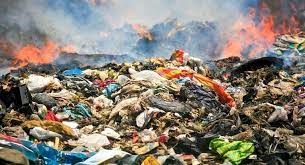
Environmental pollution caused by the fashion Industry
Environmental pollution caused by the fashion Industry
Mains Examination: General Studies Paper 3
(Environment Protection)
July 10, 2023
Foreword:
- The changing lifestyle and thinking has negatively affected the environment at many levels. The changing clothing style and fashion around the world has reduced the risk of polluting the environment in various ways. Due to the textile industry, the problem of environmental pollution, water crisis, chemical pollution, carbon emissions and waste is increasing worldwide.
Causes and Its Impacts:
- Textile industry i.e. fashion industry is one of the most polluting industries in the world. Water, chemicals and energy are used indiscriminately at every stage of textile production. It has a deep negative impact on the environment. This has created many such problems, which cannot be ignored, but the demands of changing fashion have ignored all those problems, including environmental problems.
- According to research, the fashion industry accounts for 10 percent of global carbon emissions, which is expected to increase steadily until 2030.
Over-exploitation of groundwater:
- The fashion industry produces over 92 million tonnes of waste and consumes 1.5 trillion tonnes of water every year.
- According to a research, the fashion industry has ten percent share in climate change. This is the biggest threat to groundwater.
- In fact, textile companies exploit groundwater the most.
- Bangladesh is the second largest textile exporting country in the world. According to statistics, Bangladesh's textile industry extracts 1,500 billion liters of water from the earth annually. Significantly, 250 liters of water is wasted in washing one kg of denim.
- 200 liters of water is consumed in washing and dyeing one kg of cotton cloth. This is the reason why the ground water level in Bangladesh is continuously going down. If the amount of water that is wasted in the textile industry in Bangladesh is used for drinking purposes, about two crore people can get drinking water for ten months.
Excessive use of synthetic fabrics
- Fashion and sustainable fabrics Synthetic fibers such as nylon, polyester and spandex, used in the production of clothing, do not decompose for centuries. These have become a serious challenge towards environmental improvement.
- Rayon, a fabric made from wood pulp, contributes to deforestation and is extremely harmful to habitat destruction and biodiversity.
High Demand for fashionable clothes
- Recent studies on the fashion industry in Britain, America, Sweden and Finland have shown that fashion affects all those areas, including the environment, with which there is a deep relationship between the earth and the creatures living on it.
- The Indian textile industry is known for its skilled craftsmen, which include embroidery and embellishments. The clothing brand that has started running in India, it dominates the market in such a way that while buying it, no one thinks about whether it is harming the environment.
- The fashion industry has grown at a doubling rate over the last fifteen years, but there has been a forty percent drop in the amount of time a purchased garment is worn before being thrown out.
- Statistics show that worn clothes are thrown away or burnt. Significantly, in both cases, the environment is affected. Only 12 percent is used for burying and recycling.
- According to a survey, the interest in fashion in villages is much less than in cities. That's why the problem of environment is continuously increasing in the cities.
- The trend of looking 'stylish' is becoming like an addiction. This is also affecting the health adversely.
- According to doctors, stylish bags full of clothes can cause back and neck pain. According to a research, wearing tight shirt collars and ties can lead to eye problems due to reduced blood flow to the brain.
- Wearing a pencil skirt can cause stiffness in the legs. In this way, fashion is increasing many such problems, which can slow down the pace of life or make us sick.
use and throw away ideology
- In many countries of the world including India, the use and throw ideology has also increased due to the inclusion of fashion in people, the habit of showing off and carelessness towards the environment. Due to insensitivity in the cities, people remain careless even towards serious incidents happening around them. Therefore, while environmental problems have increased, violent activities and various types of riots have also increased.
Conclusions:
- According to the study, the textile and fashion industry has a long supply chain, which extends from agriculture and fiber production to supply, manufacturing and retail.
- Such clothing has become a global waste problem, although awareness of the ecological impact of fashion has already increased, leading to an increase in the production of sustainable clothing. Better working conditions for the laborers engaged in such industries, better quality of the cloth and better work and wages for the artisans engaged in better craftsmanship will increase the demand for such clothes
- In all the countries of the world including India, there is a need to change the dress, the habit of collecting things in the name of fashion and the habit of use and throw in view of environmental pollution and many other problems.
- If instead people are interested in eco-friendly brands of sustainable clothing, then the problems caused by the textile industry can be reduced. Fashion is a necessity of the society, but when it is causing problems, it cannot be justified.
----------------------------
Mains Exam Question
How has the fashion industry polluted the environment? Discuss.